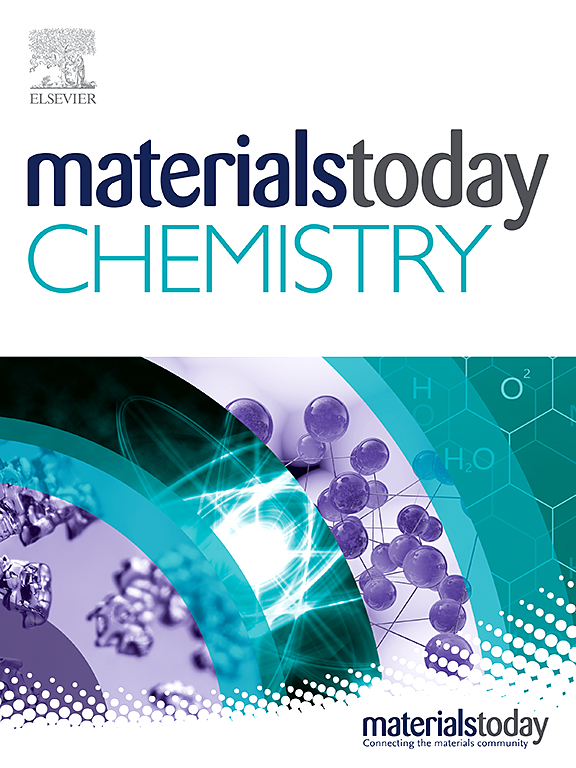Increase the inversion degree in Er-doped MgGa2O4 spinel nanofilms to obtain strong electroluminescence
IF 6.7
2区 化学
Q1 CHEMISTRY, MULTIDISCIPLINARY
引用次数: 0
Abstract
The GaO/MgO/ErO nanolaminates are fabricated by atomic layer deposition and crystallized into Er-doped MgGaO spinel (MGS:Er) nanofilms after annealing, with their electroluminescence (EL) performance characterized. The annealing above 600 °C achieves the polycrystalline spinel nanofilm, and the crystallization is promoted by the higher annealing temperature and GaO/MgO ratio. The dopant Er ions preferably substitute into the octahedron sites occupied by Ga ions in ordinary spinel and Mg in anti-spinel lattice, while the inversion degree is confirmed to increase with the reduction of GaO/MgO ratio and annealing temperature, resulting the relatively enhanced secondary EL at 1542 nm. This perturbation by Er-substitution into anti-spinel sites improves the emission intensity and excitation efficiencies, the main EL emission peaking at 1531 nm from the optimal MGS:Er device exhibits the excitation efficiency reaching 5.8 %, with the enhanced electrical injection realizing the maximum EL intensity above 17.3 mW/cm. The fluorescence lifetime of these MGS:Er devices is established in the range of 371–760 μs, which decreases mainly with the Er concentrations. The prototype device using the near-stoichiometric GaO/MgO ratio shows the operation time of 1.12 × 10 s. This work explores the fabrication of Si-based spinel nanofilms with designed composition and special microstructure, and their practical application in optoelectronics.提高掺杂 Er 的 MgGa2O4 尖晶石纳米薄膜的反转度以获得强电致发光性能
通过原子层沉积制备了 GaO/MgO/ErO 纳米层压板,并在退火后结晶成掺铒 MgGaO 尖晶石(MGS:Er)纳米薄膜,其电致发光(EL)性能得到了表征。600 °C 以上的退火温度可获得多晶尖晶石纳米薄膜,较高的退火温度和 GaO/MgO 比率可促进结晶。掺杂剂 Er 离子优先取代了普通尖晶石中 Ga 离子和反尖晶石晶格中 Mg 离子占据的八面体位点,而反转程度则随着 GaO/MgO 比率和退火温度的降低而增加,从而导致 1542 纳米波长的二次电致发光相对增强。Er 取代反尖晶石位点的扰动提高了发射强度和激发效率,最佳 MGS:Er 器件在 1531 nm 处的主要 EL 发射峰值的激发效率达到 5.8%,增强的电注入实现了 17.3 mW/cm 以上的最大 EL 强度。这些 MGS:Er 器件的荧光寿命为 371-760 μs,主要随 Er 浓度的增加而降低。这项研究探索了具有设计成分和特殊微观结构的硅基尖晶石纳米薄膜的制备及其在光电子领域的实际应用。
本文章由计算机程序翻译,如有差异,请以英文原文为准。
求助全文
约1分钟内获得全文
求助全文
来源期刊

Materials Today Chemistry
Multiple-
CiteScore
8.90
自引率
6.80%
发文量
596
审稿时长
33 days
期刊介绍:
Materials Today Chemistry is a multi-disciplinary journal dedicated to all facets of materials chemistry.
This field represents one of the fastest-growing areas of science, involving the application of chemistry-based techniques to the study of materials. It encompasses materials synthesis and behavior, as well as the intricate relationships between material structure and properties at the atomic and molecular scale. Materials Today Chemistry serves as a high-impact platform for discussing research that propels the field forward through groundbreaking discoveries and innovative techniques.
 求助内容:
求助内容: 应助结果提醒方式:
应助结果提醒方式:


